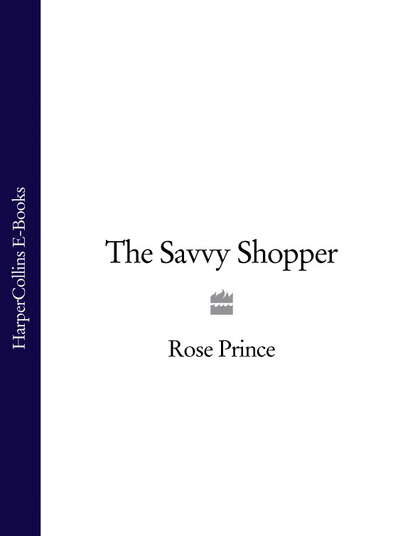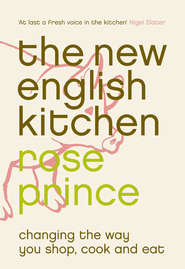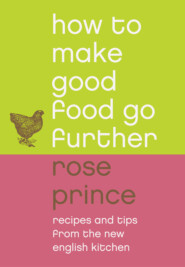По всем вопросам обращайтесь на: info@litportal.ru
(©) 2003-2024.
✖
The Savvy Shopper
Настройки чтения
Размер шрифта
Высота строк
Поля
Sainsbury: 0800 636262
Somerfield: 0117 935 9359
Tesco: 0800 5055 5555
Waitrose: 0800 188884
But however many pounds in every ten we spend at Tesco, small shops still exist. Great butcher’s shops, cheese shops, specialist food shops, bakeries, fishmonger’s and even a few greengrocer’s cling on in the high streets – please seek them out. They actually have shop assistants who can talk knowledgeably to you, and may even help carry bags and give cooking advice. Yep, pinch yourself, you’re having a pleasant shopping experience.
Farm shops are my favourite, partly because they make superb meat and just-picked organic produce affordable. No high-street rents and no middle men mean lower prices. And you can take the car – very eco-unfriendly, but you can hardly tramp across fields with your shopping.
Low prices for fresh food are promoted by the supermarkets but before you rush to buy the free-range chicken or English asparagus at Tesco, check the price at your farm shop, butcher’s or local produce stalls. Three experiments carried out by my husband, Dominic Prince, in 2004/2005, in the Evening Standard, the Spectator Magazine and on ‘Tonight with Trevor McDonald’ (ITV), revealed certain prices at the small shops to be up to 40 per cent lower than those at Tesco – a considerable margin.
Online shopping for home-delivered food is another way to buy the best-quality food at the right price. I still find the worldwide web a weird shop. I am unable quite to complete the transaction without phoning the online shop about something quite unnecessary, just to make sure that there are people and not Martians running the place. But mail order is great. Don’t be put off by the home-delivery practicalities. Most online or mail-order companies will organise a delivery time to suit you, or bring it to your office if that helps, or give the delivery to a neighbour or hide it in the garden shed in your absence. Once you have dealt successfully with a home-delivery supplier for the first time, it’s a good idea to add the clause ‘leave unsigned’ to the order, particularly if you have a good hiding place. Small companies are flexible about this, although some will not do it for safety reasons.
The higher price of good food
The cost of naturally reared meat, organic vegetables and good-quality, additive-free ready-made foods will always be higher than budget-priced, intensively produced, additive-heavy foods. One of the most off-putting elements in changing shopping habits, when we are so used to paying less, is the higher price. But by balancing the ratio of luxury foods to cheap, everyday items and finding out how to use cheap cuts of meat, using up leftovers so we don’t waste a thing, and buying into gluts when they are at their cheapest (and most delicious), it is possible to keep the bill close to the old one. This kind of latter-day household management was the subject of my first book, The New English Kitchen (Fourth Estate, 2005). Many of its recipes show how the finest food will fit inside a tight budget. Think twice, for example, before you throw away the chicken carcass. Remember that stock can be made from its bones and used to make a risotto, so in the end it contributes to two meals.
Health, nutrition and functional food
In the past twenty years obesity rates in the UK have trebled, to 20 per cent of adults and 10 per cent of children. The food industry is – rightly – under fire for manufacturing and promoting unhealthy food. The industry responds by saying that, if we all took more exercise, it would not matter that we consume too many fats and sugars. I predict that the industry will wish it had not ignored its responsibility for so long. Some food manufacturers are reducing fat, salt and sugar content in the food they make; a time may even come when we laugh at the way we gave children sugar-coated breakfast cereals, in the same way our parents giggle at how their GP once offered a cigarette during a consultation. The authorities are trying to catch up on the situation, again far too late. The Food Standards Agency’s suggested proposal of a red –amber–green ‘Traffic Light’ warning logo on food was trounced in early 2006 by the announcement that some of the biggest players in the industry plan voluntarily to change the nutritional information on their packaging, giving the RDA (recommended daily allowance) of each particular food. That the daily allowance of any particular food will be decided by the manufacturer is laughable – but it could also be seriously confusing to the consumer.
It may be true that all food is nourishment to a degree, but what we put in our bodies is now a major preoccupation. The food industry – no slouch when it comes to fashion – has responded with ‘functional foods’, foods with added beneficial ingredients, such as pro-biotic yoghurt drinks (said to aid digestion) and chickens with added essential omega-3 fatty acids (for heart and tissue health). Before you throw these things in the trolley, bear in mind that, unlike those made by pharmaceutical companies or even herbal remedies, the health claims on food labelling need not be backed up. The functional food industry is also expecting that these rules will be relaxed further in the near future. Take omega-3: there is no doubt that these fatty acids are heart-healthy, but I’m sorry to say that there is just not enough evidence to prove they boost brain power except in premature babies. The food industry is set to make billions out of gullibility. Nutritionists all say the same thing: stick to eating, or feeding your kids, a varied diet made up of fresh foods, freshly cooked.
Packaging
Try to picture one and a half billion dustbins full of waste, inside them 12 billion carrier bags, at least one billion emblazoned with the names of our major supermarkets. Add to this a few billion glass jars, bottles and cans that missed the recycling bin. And then imagine burying the whole lot. Choose a spot. The Lake District? The Norfolk Broads? The Wiltshire Downs? It has to go somewhere and much of it, sad to say, is the debris of our dinners.
Waste Watch, a government-funded agency, reports that 28 million tonnes of waste are generated by UK households annually, of which only 11 per cent is recycled; 81 per cent is dumped in landfill sites and space is running out without more recycling. The government has said that the food and drink industry is a major source of waste, accounting for 10 per cent of all industrial and commercial waste, ‘notably packaging’.
The figures for recycled waste have gone up encouragingly but there is still a problem with packaging. Most irritating is the pass-the-parcel package: cardboard cartons containing 12 boxes of cellophane-wrapped biscuits are typical. Chocolate packaging can be outrageous. Have you ever scrabbled desperately through cellophane wrapping and a triple-thickness cardboard box, then removed a sticker from a waxed paper layer to reveal another of corrugated paper, under which 12 chocolates are sitting, wrapped in foil? Some suppliers use recycled, biodegradable packaging, but less is better. Brown paper bags are a great wrapping for vegetables and fruit, newsprint good for meat and fish and, if you shop by car, it is good to take boxes from supermarkets, not carrier bags. Or use baskets. Feel superior at the checkout, putting your hand up to say ‘no’ to the carrier bag.
Building the Savvy Shopper directory
There is a shopping guide for each food featured in this book. Many of the suppliers were found when I was writing the Savvy Shopper articles for the Daily Telegraph in 2004–5 but I have also found many new sources of good food that you can buy with a clear conscience. There isn’t room to feature every food, and taste is a subjective thing, so feedback from readers and suggestions for any future updates are most welcome.
I should add that I live in the south of England, so there will be a disproportionate number of suppliers from that region in the directory. Many of them, however, offer home delivery services and will bring the shopping to your door, wherever you live. Telephone numbers are provided so that each supplier can be contacted for information about stockists and mail order.
Many of the food producers included in this book can do home delivery; if home delivery isn’t mentioned, contact them for details of stockists. I have not been able to include every small food shop on every high street, or farm shop in the countryside – but do keep an eye out for good independent shops. Nothing is more welcome to a shopper than a shop filled with good food, beautifully kept, run by knowledgeable assistants who are sympathetic to the needs of the shopper. With the creeping dominance of the chain retailers, these shops – and all those other food producers selling food with real integrity – need your loyalty and support. So be a savvy shopper and decide what the future of food shopping should be. There is considerable power in your wallet; put it to the best possible use.
HOW TO SHOP FOR BRITISH FOOD IN SEASON (#ulink_77605e16-90b0-5b72-ab13-a3066c7ecbd2)
UK-grown vegetables and fruit
New breeds, modern storage and the wider (and controversial) use of polytunnels and glasshouses mean that the season for UK-grown produce is now greatly extended. British tomatoes, for example, are available from February onwards. Supermarkets sometimes stock UK produce in preference to imports (e.g. apples, strawberries and raspberries) but unless they can buy in large quantities throughout the whole UK season for a particular vegetable or fruit, they tend to source imports, which are often cheaper. For this reason there is more chance of buying a wider variety of UK-grown produce through ‘box schemes’, which are more economical if bought direct from the farm where they are grown. Best value is to be had during the ‘glut’ – the natural window when outdoor-grown produce peaks and is at its most abundant.
Fish and shellfish
There is an optimum time to buy fish and shellfish, namely outside the spawning period of each species. This gives the fish a chance to reproduce and reduces the catch of egg-bound females. But a seasonal approach is not all a shopper needs to adopt when buying fish. Always choose large, mature fish and ask the fishmonger about the catch method: ‘line caught’ is preferable to trawled, for example. Fish from UK inshore fisheries, which tend to fish for shorter periods in smaller boats by more sustainable means, are the best choice.
Game
The season for game birds is short, but take advantage. Some species, such as grouse and woodcock, are rare and expensive but during the height of the pheasant shooting season there is a glut well worth buying into. Other, naturally wild game such as rabbit and wood pigeon are available fresh for most of the year. Wild venison has ‘close’ seasons when it can be shot but not sold; these differ between Scotland and England and Wales. The open seasons are marked on the chart that follows.
Seasonal meat and dairy produce
While most fresh meat and cheeses are now available all year round, there are still a few festive and traditional specialities that have a short season. Lamb deserves special attention. We could reduce our dependence on imports of New Zealand lamb by tapping into the supplies of the light ‘upland’ lamb and mutton available direct from farms and traditional butchers throughout the autumn and winter.
SEASONAL CHART (#ulink_a5289106-645b-5093-bfdd-3d45cd07ba41)
UK-GROWN VEGETABLES AND FRUIT
Apples (August to March)
Asparagus (May to June)
Aubergine (May to September)
Cabbages (all year round)
Carrots (June to April)
Cauliflowers (all year round)
Celeriac (October to February)
Cherries (June to July)
Courgettes (June to October)
Cucumber (February to September)
Curly kale (all year round)
Farmed blackberries (July to October or until the first frost)
Fenland celery (November to January)
Fennel (May to October)
Forced rhubarb (December to March)
French beans (July to October)
Fresh herbs (April to November)
Garlic (August to December)









